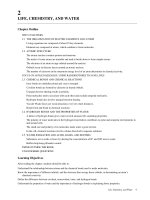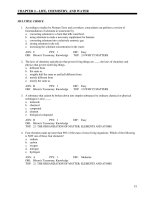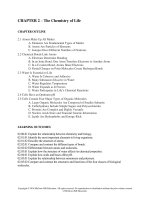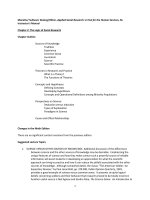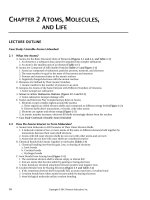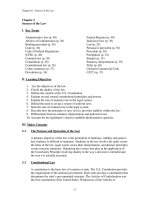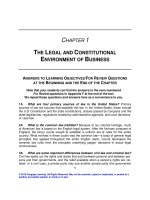Test bank and solution the chemistry of life (1)
Bạn đang xem bản rút gọn của tài liệu. Xem và tải ngay bản đầy đủ của tài liệu tại đây (77.44 KB, 26 trang )
Chapter 02 - The Chemistry of Life
Chapter 02
The Chemistry of Life
Multiple Choice Questions
1. The primary elements making up living organisms are
A. carbon, hydrogen, oxygen, and calcium.
B. carbon, oxygen, iron, and chlorine.
C. carbon, hydrogen, iron, and calcium.
D. carbon, hydrogen, oxygen, and nitrogen.
E. carbon, oxygen, sulfur, and calcium.
These four elements are required for making the macromolecules which compose all living
things. Please see section 2.1
Bloom's Level: 2. Understand
Learning Outcome: 02.00.01 Explain the chemical nature of biological molecules.
Learning Outcome: 02.01.01 Identify the most important elements in living organisms.
Section: 02.01
Topic: Atoms
Topic: Chemical Bonds
2. The atomic number of an atom or element is
A. the number of neutrons in the nucleus.
B. the number of electrons in the nucleus.
C. the number of protons in the nucleus.
D. the number of neutrons in the orbitals.
E. the number of protons in the orbitals.
The atomic number is responsible for defining the elements and its chemistry. Please see
section 2.1 for more information.
Bloom's Level: 1. Remember
Learning Outcome: 02.01.02 Describe the structure of atoms.
Section: 02.01
Topic: Atoms
2-1
Copyright © 2016 McGraw-Hill Education. All rights reserved. No reproduction or distribution without the prior written consent of
McGraw-Hill Education.
Chapter 02 - The Chemistry of Life
3. An ion could be
A. an atom that has gained electrons.
B. an atom that has a positive charge.
C. an atom that has lost electrons.
D. an atom that has a negative charge.
E. All answers are correct.
Ions can be positively or negatively charged due to the gain or loss of electrons. Please see
section 2.1 for more information.
Bloom's Level: 1. Remember
Learning Outcome: 02.01.02 Describe the structure of atoms.
Section: 02.01
Topic: Atoms
4. If you were told to sort cards to into boxes after a lab on elements, you would put into a
slot labelled "Mass Number" any card with text that meant
A. the total number of protons, neutrons, and electrons of an atom.
B. the total number of protons and electrons of an atom.
C. the total number of protons and neutrons of an atom.
D. the total number of neutrons and electrons of an atom.
E. the total number of protons of an atom.
Mass number is the total number of large particles in the nucleus of an atom. Please see
section 2.1 for more information.
Bloom's Level: 2. Understand
Learning Outcome: 02.01.02 Describe the structure of atoms.
Section: 02.01
Topic: Atoms
2-2
Copyright © 2016 McGraw-Hill Education. All rights reserved. No reproduction or distribution without the prior written consent of
McGraw-Hill Education.
Chapter 02 - The Chemistry of Life
5. Isotopes of the same element are different from one another in that
A. they have a different number of protons.
B. they have a different number of neutrons.
C. they have a different number of electrons.
D. they are a different element.
E. only one of the isotopes is matter.
Isotopes of the same element behave similarly in chemical reactions since they have the same
number of outer shell electrons. Please see section 2.1 for more information.
Bloom's Level: 1. Remember
Learning Outcome: 02.01.02 Describe the structure of atoms.
Section: 02.01
Topic: Atoms
6. If you were writing the answer key for a professor's exam, and one question asked students
to mark a box for the number of outer shell electrons possessed by an element having the
maximum number, you would have the key say that the correct answer was
A. one electron.
B. two electrons.
C. four electrons.
D. eight electrons.
E. sixteen electrons.
Two is the maximum number of outer shell electrons. Please see section 2.1 for more
information.
Bloom's Level: 3. Apply
Learning Outcome: 02.01.02 Describe the structure of atoms.
Section: 02.01
Topic: Atoms
2-3
Copyright © 2016 McGraw-Hill Education. All rights reserved. No reproduction or distribution without the prior written consent of
McGraw-Hill Education.
Chapter 02 - The Chemistry of Life
7. If an atom has a valence shell that is full, then it
A. is highly reactive.
B. is chemically unstable.
C. is highly likely to combine with other atoms.
D. is found only in a gas form.
E. is inert.
Bloom's Level: 1. Remember
Learning Outcome: 02.01.02 Describe the structure of atoms.
Section: 02.01
8. In a covalent bond
A. atoms share electrons.
B. atoms of opposite charges attract each other.
C. atoms share protons.
D. atoms share neutrons.
E. atoms are repelled by each other.
Sharing electrons leads to strong covalent bonds. Please see section 2.2 for more information.
Bloom's Level: 1. Remember
Learning Outcome: 02.02.01 Compare and contrast the different types of bonds.
Section: 02.02
Topic: Chemical Bonds
9. An ionic bond is a bond in which
A. atoms share electrons.
B. atoms share protons.
C. atoms of opposite charges attract each other.
D. atoms share neutrons.
E. atoms are repelled by each other.
Ionic bonds involve ions and transferred electrons. Please see section 2.2 for more
information.
Bloom's Level: 1. Remember
Learning Outcome: 02.02.01 Compare and contrast the different types of bonds.
Section: 02.02
Topic: Chemical Bonds
2-4
Copyright © 2016 McGraw-Hill Education. All rights reserved. No reproduction or distribution without the prior written consent of
McGraw-Hill Education.
Chapter 02 - The Chemistry of Life
10. Which statement about a bond between sodium and chlorine would lose points on an
exam?
A. Na is the chemical symbol for sodium.
B. Chlorine donates an electron.
C. Chlorine becomes negatively charged.
D. Sodium becomes positively charged.
E. The bond that is formed is a strong bond.
In this bond, chlorine gains an electron and sodium loses one. Please see section 2.2 for more
information.
Bloom's Level: 1. Remember
Learning Outcome: 02.02.01 Compare and contrast the different types of bonds.
Section: 02.02
Topic: Chemical Bonds
11. In the example of ionic bond formation between sodium and chlorine
A. Na is the chemical symbol for chlorine.
B. sodium accepts an electron.
C. chlorine accepts an electron.
D. chlorine becomes positively charged.
E. both sodium and chlorine accept electrons.
In forming the bond in sodium chloride, sodium donates an electron which chlorine accepts.
Please see section 2.2 for more information.
Bloom's Level: 2. Understand
Learning Outcome: 02.02.01 Compare and contrast the different types of bonds.
Section: 02.02
Topic: Chemical Bonds
2-5
Copyright © 2016 McGraw-Hill Education. All rights reserved. No reproduction or distribution without the prior written consent of
McGraw-Hill Education.
Chapter 02 - The Chemistry of Life
12. If a covalent bond is polar
A. electrons are not shared by atoms.
B. protons are shared by atoms.
C. it will not form in living organisms.
D. the electronegativity of atoms is unequal in their pull on electrons.
E. the bond is weak in strength.
When bonded atoms pull unequally on electrons, the resulting covalent bond is polar, with a
net partial charge on each atom. Please see section 2.2 for more information.
Bloom's Level: 2. Understand
Learning Outcome: 02.02.01 Compare and contrast the different types of bonds.
Section: 02.02
Topic: Chemical Bonds
13. A hydrogen bond
A. is generally a strong bond.
B. does not occur in living organisms.
C. does not require electron transfer.
D. forms between atoms having the same electronegativity.
E. is a specialized type of covalent bond.
Hydrogen bonds form between adjacent water molecules due to the polar nature of their
covalent bonds. Please see section 2.2 for more information.
Bloom's Level: 1. Remember
Learning Outcome: 02.02.01 Compare and contrast the different types of bonds.
Section: 02.02
Topic: Chemical Bonds
2-6
Copyright © 2016 McGraw-Hill Education. All rights reserved. No reproduction or distribution without the prior written consent of
McGraw-Hill Education.
Chapter 02 - The Chemistry of Life
14. Evaporation is
A. the conversion of a liquid into a vapor.
B. the conversion of a solid into a vapor.
C. the conversion of a vapor into a liquid.
D. the conversion of a vapor into a solid.
E. All answers are correct.
Liquids evaporate as their molecules obtain enough energy to escape from solution into the
atmosphere. Please see section 2.3 for more information.
Bloom's Level: 1. Remember
Learning Outcome: 02.03.01 Explain how the structure of water affects its chemical properties.
Section: 02.03
Topic: Chemical Bonds
Topic: Properties of Water
15. A friend who is not taking your Biology course fills a cup with ice and then a drink. The
friend asks you why the ice in the cup is floating, and you are able to say that
A. the molecules are closer together in ice than in liquid water.
B. the molecules are farther apart in ice than in liquid water.
C. ice is denser than liquid water.
D. convection currents caused by temperature differences push upwards on the ice.
E. water vapor is less dense than liquid water.
Water is less dense when frozen than when liquid due to the structure of ice that results
because of hydrogen bonding. Please see section 2.3 for more information.
Bloom's Level: 2. Understand
Learning Outcome: 02.03.01 Explain how the structure of water affects its chemical properties.
Section: 02.03
Topic: Properties of Water
2-7
Copyright © 2016 McGraw-Hill Education. All rights reserved. No reproduction or distribution without the prior written consent of
McGraw-Hill Education.
Chapter 02 - The Chemistry of Life
16. In a chemical equation
A. the reactants are on the right of the yields arrow.
B. reactants and products are on both sides of the yields arrow.
C. the products are on the left of the yields arrow.
D. the reactants are on the left of the yields arrow.
E. the number of atoms of each element may differ on the two sides of the yields arrow.
A chemical reaction shows the progress from reactants to products. Please see section 2.3 for
more information.
Bloom's Level: 1. Remember
Learning Outcome: 02.03.01 Explain how the structure of water affects its chemical properties.
Section: 02.03
Topic: Chemical Reactions
Topic: Properties of Water
17. An acid
A. has a value above 7 on the pH scale.
B. is a chemical that takes hydrogen ions from a solution.
C. has a value of 7 on the pH scale.
D. is a chemical that adds hydrogen ions to a solution.
E. All answers are correct.
Acids have low pH's, with more protons in solution. Please see section 2.4 for more
information.
Bloom's Level: 1. Remember
Learning Outcome: 02.04.01 Explain how acids and bases affect pH.
Section: 02.04
Topic: Acids and Bases
2-8
Copyright © 2016 McGraw-Hill Education. All rights reserved. No reproduction or distribution without the prior written consent of
McGraw-Hill Education.
Chapter 02 - The Chemistry of Life
18. A base
A. has a value of 7 on the pH scale.
B. is a chemical that adds hydrogen ions to a solution.
C. is a chemical that absorbs hydrogen ions from a solution.
D. has a value below 7 on the pH scale.
Bases take up hydrogen ions and raise pH. Please see section 2.4 for more information.
Bloom's Level: 1. Remember
Learning Outcome: 02.04.01 Explain how acids and bases affect pH.
Section: 02.04
Topic: Acids and Bases
19. A substance with a pH of 2 is
A. neutral.
B. a weak acid.
C. a weak base.
D. a strong base.
E. a strong acid.
Strong acids have low pH's, well below the neutral pH of 7. Please see section 2.4 for more
information.
Bloom's Level: 1. Remember
Learning Outcome: 02.04.01 Explain how acids and bases affect pH.
Section: 02.04
Topic: Acids and Bases
2-9
Copyright © 2016 McGraw-Hill Education. All rights reserved. No reproduction or distribution without the prior written consent of
McGraw-Hill Education.
Chapter 02 - The Chemistry of Life
20. As part of an exam, you are given a powder to analyze. When you perform various tests,
you find that it contains a single chemical that changes the pH of neutral water to a pH of 6.
You would conclude that the chemical is a
A. weak acid.
B. neutral.
C. weak base.
D. strong acid.
E. strong base.
Weak acids change pH by lowering it, but not by a large amount. Please see section 2.4 for
more information.
Bloom's Level: 1. Remember
Learning Outcome: 02.04.01 Explain how acids and bases affect pH.
Section: 02.04
21. A substance with a pH of 7 is
A. a weak acid.
B. a weak base.
C. neutral.
D. a strong acid.
E. a strong base.
A pH of 7 means that there is not net excess of hydrogen or hydroxyl ions in solution. Please
see section 2.4 for more information.
Bloom's Level: 2. Understand
Learning Outcome: 02.04.01 Explain how acids and bases affect pH.
Section: 02.04
Topic: Acids and Bases
2-10
Copyright © 2016 McGraw-Hill Education. All rights reserved. No reproduction or distribution without the prior written consent of
McGraw-Hill Education.
Chapter 02 - The Chemistry of Life
22. As part of a lab exam, you are given a vial of orange crystals. When you add them to
pure, neutral pH water, the pH changes to 13. Other tests show that the crystals consist of as
single chemical, which you could conclude is
A. a weak acid.
B. a weak base.
C. neutral.
D. a strong acid.
E. a strong base.
Strong bases make pH swing much higher, away from 7. Please see section 2.4 for more
information.
Bloom's Level: 1. Remember
Learning Outcome: 02.04.01 Explain how acids and bases affect pH.
Section: 02.04
Topic: Acids and Bases
23. Organic molecules are defined as chemical compounds that contain
A. hydrophilic solutions.
B. isotopes of carbon.
C. ionically bonded atoms.
D. strong hydrogen bonds.
E. carbon and hydrogen.
Organic molecules, while they may include other elements, by definition must contain
hydrogen and oxygen. Please see section 2.5 for more information.
Bloom's Level: 1. Remember
Learning Outcome: 02.05.01 Explain the relationship between monomers and polymers.
Section: 02.05
Topic: Carbohydrates
Topic: Lipids
Topic: Nucleic Acids
Topic: Proteins
2-11
Copyright © 2016 McGraw-Hill Education. All rights reserved. No reproduction or distribution without the prior written consent of
McGraw-Hill Education.
Chapter 02 - The Chemistry of Life
24. The four major groups of organic compounds are
A. fats, waxes, carbohydrates, and amino acids.
B. carbohydrates, lipids, steroids, and monosaccharides.
C. lipids, fats, waxes, and steroids.
D. carbohydrates, lipids, proteins, and nucleic acids.
E. carbohydrates, proteins, amino acids, and nucleic acids.
All living things are made of carbohydrates, lipids, nucleic acids, and proteins. Please see
section 2.5 for more information.
Bloom's Level: 1. Remember
Learning Outcome: 02.00.01 Explain the chemical nature of biological molecules.
Learning Outcome: 02.05.01 Explain the relationship between monomers and polymers.
Learning Outcome: 02.05.02 Compare and contrast the structures and functions of the four classes of biological molecules.
Section: 02.05
Topic: Carbohydrates
Topic: Lipids
Topic: Nucleic Acids
Topic: Proteins
25. You are asked to help prepare a lab and need to label some beakers. In one, you are told,
there are sugars polymerizing into a large polymer, so you prepare a label that mentions
A. hydrolysis.
B. reproduction.
C. dehydration synthesis.
D. hydrolysis and dehydration synthesis.
E. unrelated to chemical bonds.
Monomers are turned into polymers in living systems by the removal of water, dehydration.
Please see section 2.5 for more information.
Bloom's Level: 3. Apply
Learning Outcome: 02.00.01 Explain the chemical nature of biological molecules.
Learning Outcome: 02.05.01 Explain the relationship between monomers and polymers.
Section: 02.05
Topic: Chemical Bonds
Topic: Molecules
2-12
Copyright © 2016 McGraw-Hill Education. All rights reserved. No reproduction or distribution without the prior written consent of
McGraw-Hill Education.
Chapter 02 - The Chemistry of Life
26. A process by which cells break polymers down into smaller units is
A. hydrolysis.
B. dehydration synthesis.
C. reproduction.
D. hydrolysis and dehydration synthesis.
E. unrelated to chemical bonds.
When water is added chemically to a bond between the subunits in a polymer, breaking that
bond, the reaction is a hydrolysis reaction. Please see section 2.5 for more information.
Bloom's Level: 1. Remember
Learning Outcome: 02.05.02 Compare and contrast the structures and functions of the four classes of biological molecules.
Section: 02.05
Topic: Carbohydrates
Topic: Chemical Reactions
Topic: Lipids
Topic: Proteins
27. Imagine that you are in a study session, and your group is taking a practice quiz that
members grade for one another. For the question, "A cook decides to cook only using
monomers, so what chemicals could the cook use?" you would mark correct if the paper you
are grading has this answer as
A. cellulose and sucrose.
B. lactose and sucrose.
C. glucose and fructose.
D. glucose and cellulose.
E. None of the answers are correct.
Monosaccharides are single sugars molecules not linked to any others. Please see section 2.5
for more information.
Bloom's Level: 2. Understand
Learning Outcome: 02.05.02 Compare and contrast the structures and functions of the four classes of biological molecules.
Section: 02.05
Topic: Carbohydrates
Topic: Molecules
2-13
Copyright © 2016 McGraw-Hill Education. All rights reserved. No reproduction or distribution without the prior written consent of
McGraw-Hill Education.
Chapter 02 - The Chemistry of Life
28. You are asked to help solve a murder, and a note from the murdered taunting the police
says that the crime was committed using a lipid. What molecule could you exclude from your
search?
A. a triglyceride
B. a phospholipid
C. a wax
D. a sterol
E. a starch molecule
Starch is a carbohydrate, not a lipid. Please see section 2.5 for more information.
Bloom's Level: 3. Apply
Learning Outcome: 02.05.02 Compare and contrast the structures and functions of the four classes of biological molecules.
Section: 02.05
Topic: Lipids
29. The primary building block (monomer) of proteins is
A. a glucose molecule.
B. a fatty acid.
C. a nucleotide.
D. an amino acid.
E. four interconnected rings.
Proteins are made of amino acids linked by the removal of water. Please see section 2.5 for
more information.
Bloom's Level: 1. Remember
Learning Outcome: 02.05.02 Compare and contrast the structures and functions of the four classes of biological molecules.
Section: 02.05
Topic: Molecules
Topic: Proteins
2-14
Copyright © 2016 McGraw-Hill Education. All rights reserved. No reproduction or distribution without the prior written consent of
McGraw-Hill Education.
Chapter 02 - The Chemistry of Life
30. If asked to build a model of an amino acid, you would need parts to represent
A. three R groups and a glycerol.
B. nitrogen, carbon, and an R group.
C. multiple saccharide rings.
D. carbon and phosphorus monomers.
E. carbon and phosphorus.
Amino acids have amino and carboxyl groups in common, and they vary based on the
identity of their R groups. Please see section 2.5 for more information.
Bloom's Level: 2. Understand
Learning Outcome: 02.05.02 Compare and contrast the structures and functions of the four classes of biological molecules.
Section: 02.05
Topic: Proteins
31. As part of a lab practical, you are asked to attach explanation to labels on chemical
models. To the link between amino acids in a protein you would add a label describing that it
is
A. an ionic bond in proteins.
B. a covalent bond in carbohydrates.
C. a covalent bond in proteins.
D. an ionic bond in carbohydrates.
E. a hydrogen bond in nucleic acids.
Peptide bonds link successive amino acids in a protein. Please see section 2.5 for more
information.
Bloom's Level: 2. Understand
Learning Outcome: 02.05.02 Compare and contrast the structures and functions of the four classes of biological molecules.
Section: 02.05
Topic: Molecules
Topic: Proteins
2-15
Copyright © 2016 McGraw-Hill Education. All rights reserved. No reproduction or distribution without the prior written consent of
McGraw-Hill Education.
Chapter 02 - The Chemistry of Life
32. The primary building block (monomer) of nucleic acids is
A. a nucleotide.
B. a glucose molecule.
C. a fatty acid.
D. an amino acid.
E. four interconnected carbon rings.
Nucleic acids are polymers, and they are composed of a set of four nucleotides linked by the
removal of water. Please see section 2.5 for more information.
Bloom's Level: 1. Remember
Learning Outcome: 02.05.01 Explain the relationship between monomers and polymers.
Learning Outcome: 02.05.02 Compare and contrast the structures and functions of the four classes of biological molecules.
Section: 02.05
Topic: Molecules
Topic: Nucleic Acids
33. Water is best described as which of the following?
A. an ion
B. a nonpolar molecule
C. an atom
D. a polar molecule
E. an element
Water is a polar molecule composed of three atoms of two elements. Please see section 2.3
for more information.
Bloom's Level: 2. Understand
Learning Outcome: 02.03.01 Explain how the structure of water affects its chemical properties.
Section: 02.03
Topic: Properties of Water
2-16
Copyright © 2016 McGraw-Hill Education. All rights reserved. No reproduction or distribution without the prior written consent of
McGraw-Hill Education.
Chapter 02 - The Chemistry of Life
34. You have been presented with a new compound that is bright purple and that smells of
violets. However, it sticks to surfaces in a way similar to water and can replace water in the
running of living cells. You might then expect this new molecule to make
A. covalent bonds.
B. ionic bonds.
C. hydrogen bonds.
D. hydrophobic bonds.
E. peptide bonds.
Water molecules' ability to make hydrogen bonds is critical for their function in cells, so any
substitute for water would probably make the same bonds. Please see section 2.3 for more
information.
Bloom's Level: 4. Analyze
Learning Outcome: 02.03.01 Explain how the structure of water affects its chemical properties.
Section: 02.03
Topic: Properties of Water
35. Within a single molecule of water, ____ bonds are formed between oxygen and
hydrogen.
A. ionic
B. covalent
C. hydrogen
D. hydrophobic
E. nuclear
Internal bonds in water molecules are polar covalent bonds. Please see section 2.3 for more
information.
Bloom's Level: 2. Understand
Learning Outcome: 02.03.01 Explain how the structure of water affects its chemical properties.
Section: 02.03
2-17
Copyright © 2016 McGraw-Hill Education. All rights reserved. No reproduction or distribution without the prior written consent of
McGraw-Hill Education.
Chapter 02 - The Chemistry of Life
36. What do a lemon, a toaster oven, and sand grains have in common?
A. All are composed of matter and energy.
B. All are alive.
C. All are composed of organic molecules.
D. All are acidic.
E. All are basic.
All material things are made of matter and have energy in them. Please see section 2.1 for
more information.
Bloom's Level: 3. Apply
Learning Outcome: 02.00.01 Explain the chemical nature of biological molecules.
Learning Outcome: 02.01.01 Identify the most important elements in living organisms.
Section: 02.01
Topic: Atoms
37. You can painlessly wade into a pool, but doing a belly flop off of the high diving board
hurts because of
A. water's high density.
B. adhesion of your molecules with the water molecules.
C. water's high boiling point.
D. a neutral pH.
E. cohesion of the water molecules.
The cohesiveness of water molecules leads to tighter bonding between them than in other
solvents, and thus the difficulty/pain involved in a belly flop. Please see section 2.3 for more
information.
Bloom's Level: 3. Apply
Learning Outcome: 02.03.01 Explain how the structure of water affects its chemical properties.
Section: 02.03
Topic: Properties of Water
Scientists use carbon dating to determine the age of fossils. 14C is a rare isotope of carbon
that has a half life of 5730 years and decays into 14N. By measuring the amount of 14C
remaining in a fossil, scientists can estimate when the organism died to within 60,000 years.
2-18
Copyright © 2016 McGraw-Hill Education. All rights reserved. No reproduction or distribution without the prior written consent of
McGraw-Hill Education.
Chapter 02 - The Chemistry of Life
The atomic numbers of C is 6 and of N is 7.
38. The most common isotope of carbon is 12C. 14C has ____ than 12C.
A. more protons
B. more neutrons
C. fewer neutrons
D. fewer protons
E. more electrons
Higher atomic number means that more neutrons are present, for isotopes of the same
element. Please see section 2.1 for more information.
Bloom's Level: 3. Apply
Learning Outcome: 02.01.01 Identify the most important elements in living organisms.
Learning Outcome: 02.01.02 Describe the structure of atoms.
Section: 02.01
Topic: Atoms
39. 14C and 14N have the same
A. atomic number.
B. number of protons.
C. atomic mass.
D. number of neutrons.
E. number of electrons.
Different elements can have the same atomic number depending on what isotopes are being
compared. Please see sections 2.1 and 2.2 for more information.
Bloom's Level: 4. Analyze
Learning Outcome: 02.01.01 Identify the most important elements in living organisms.
Learning Outcome: 02.01.02 Describe the structure of atoms.
Section: 02.01
Section: 02.02
Topic: Atoms
2-19
Copyright © 2016 McGraw-Hill Education. All rights reserved. No reproduction or distribution without the prior written consent of
McGraw-Hill Education.
Chapter 02 - The Chemistry of Life
40. Which of the following is NOT an example of matter?
A. wind
B. energy
C. light
D. sound
E. None of the answers are correct.
Wind is the movement of matter, not matter itseld. Please see section 2.1 for more
information.
Bloom's Level: 1. Remember
Learning Outcome: 02.00.01 Explain the chemical nature of biological molecules.
Learning Outcome: 02.01.01 Identify the most important elements in living organisms.
Section: 02.01
Topic: Atoms
41. Hydrogen, nitrogen, carbon, and oxygen account for 96% of the human body. These
elements are
A. also the main elements in organic molecules.
B. rare in nonhuman organisms.
C. rare on Earth.
D. always bonded by hydrogen bonds.
E. All answers are correct.
The human body is made, mostly, of organic compounds, so it and organic compounds share
common elements. Please see section 2.1 for more information.
Bloom's Level: 1. Remember
Learning Outcome: 02.00.01 Explain the chemical nature of biological molecules.
Learning Outcome: 02.01.01 Identify the most important elements in living organisms.
Section: 02.01
Section: 02.02
Topic: Atoms
2-20
Copyright © 2016 McGraw-Hill Education. All rights reserved. No reproduction or distribution without the prior written consent of
McGraw-Hill Education.
Chapter 02 - The Chemistry of Life
42. The polymers with the most complex and diverse three-dimensional structures are
A. saturated fats.
B. unsaturated fats.
C. proteins.
D. waxes.
E. carbohydrates.
Proteins generally have more kinds of monomers than other large polymers, so they can have
a greater diversity of shapes and functions. Please see section 2.5 for more information.
Bloom's Level: 2. Understand
Learning Outcome: 02.05.02 Compare and contrast the structures and functions of the four classes of biological molecules.
Section: 02.05
Topic: Proteins
True / False Questions
43. Water is a compound.
TRUE
Water is a compound since it contains more than one chemical element. Please see sections
2.2 and 2.3 for more information.
Bloom's Level: 2. Understand
Learning Outcome: 02.02.02 Differentiate between atoms, molecules, and compounds.
Learning Outcome: 02.03.01 Explain how the structure of water affects its chemical properties.
Section: 02.02
Section: 02.03
Topic: Chemical Bonds
Topic: Properties of Water
2-21
Copyright © 2016 McGraw-Hill Education. All rights reserved. No reproduction or distribution without the prior written consent of
McGraw-Hill Education.
Chapter 02 - The Chemistry of Life
44. Proteins are compound because they are polymers.
FALSE
Proteins are compounds, but because they are made of multiple elements. Please see section
1.2 for more information.
Bloom's Level: 1. Remember
Learning Outcome: 02.02.02 Differentiate between atoms, molecules, and compounds.
Section: 02.02
Topic: Atoms
Topic: Molecules
Multiple Choice Questions
45. Two hydrogen atoms and an oxygen atom bonded together form
A. a molecule, but not a compound.
B. a compound, but not a molecule.
C. a molecule and a compound.
D. an atom and a molecule.
E. an atom, but not a molecule or compound.
Molecules involve multiple atoms, and compounds involve multiple elements. Please see
section 2.2 for more information.
Bloom's Level: 2. Understand
Learning Outcome: 02.02.02 Differentiate between atoms, molecules, and compounds.
Section: 02.02
Topic: Atoms
Topic: Molecules
2-22
Copyright © 2016 McGraw-Hill Education. All rights reserved. No reproduction or distribution without the prior written consent of
McGraw-Hill Education.
Chapter 02 - The Chemistry of Life
True / False Questions
46. Some aphids can change color in response to the presence of bacterial symbionts.
TRUE
Baterial symbionts can prompt some aphids to shift color from red to green. Please see
section 2.5 and "Investigating Life" for more information.
Bloom's Level: 1. Remember
Learning Outcome: 02.06.02 Understand the role of bacterial symbionts in aphid coloration
Section: 02.06
Topic: Molecules
Type: Investigating Life
47. Aphids that change color in response to the presence of bacterial symbionts generally do
so as they age.
TRUE
Baterial symbionts can prompt some young aphids to shift color from red to green. Please see
section 2.5 and "Investigating Life" for more information.
Bloom's Level: 1. Remember
Learning Outcome: 02.06.02 Understand the role of bacterial symbionts in aphid coloration
Section: 02.06
Topic: Molecules
Type: Investigating Life
48. Color changes are not connected to their survival.
FALSE
A color shift in aphids from red to green can lead to camouflage effects and greater survival.
Please see section 2.5 and "Investigating Life" for more information.
Bloom's Level: 1. Remember
Learning Outcome: 02.06.02 Understand the role of bacterial symbionts in aphid coloration
Section: 02.06
Topic: Molecules
Type: Investigating Life
2-23
Copyright © 2016 McGraw-Hill Education. All rights reserved. No reproduction or distribution without the prior written consent of
McGraw-Hill Education.
Chapter 02 - The Chemistry of Life
Multiple Choice Questions
49. If you add a factor to a culture of sap-sukcing mealy bugs, and they change color from
red to green, what might you have added?
A. bacteria
B. seeds
C. caffeine
D. salt
E. wax
This example sounds like the case in which added bacteria caused aphids to change from red
to green. Please see section 2.5 and "Investigating Life" for more information.
Bloom's Level: 3. Apply
Learning Outcome: 02.05.02 Compare and contrast the structures and functions of the four classes of biological molecules.
Learning Outcome: 02.06.02 Understand the role of bacterial symbionts in aphid coloration
Section: 02.05
Section: 02.06
Topic: Molecules
Type: Investigating Life
50. If you wanted to add a factor to a culture grasshoppers to see if it might cause a color
change, what might you try?
A. bacteria
B. seeds
C. caffeine
D. salt
E. wax
Added bacteria can cause some aphids to change from red to green. Please see section 2.5
and "Investigating Life" for more information.
Bloom's Level: 4. Analyze
Learning Outcome: 02.05.02 Compare and contrast the structures and functions of the four classes of biological molecules.
Learning Outcome: 02.06.02 Understand the role of bacterial symbionts in aphid coloration
Section: 02.05
Section: 02.06
Topic: Molecules
Type: Investigating Life
2-24
Copyright © 2016 McGraw-Hill Education. All rights reserved. No reproduction or distribution without the prior written consent of
McGraw-Hill Education.
Chapter 02 - The Chemistry of Life
51. If you sprayed antibiotics on purple insects, and they changed color, what did the
antibiotics most likely affect?
A. bacteria
B. seeds
C. caffeine
D. salt
E. wax
Added bacteria can cause some aphids to change from red to green, and antibiotics kill
bacteria. Please see section 2.5 and "Investigating Life" for more information.
Bloom's Level: 2. Understand
Learning Outcome: 02.05.02 Compare and contrast the structures and functions of the four classes of biological molecules.
Learning Outcome: 02.06.02 Understand the role of bacterial symbionts in aphid coloration
Section: 02.05
Section: 02.06
Topic: Molecules
Type: Investigating Life
True / False Questions
52. Polymers are made of monomers, and both are kinds of compounds.
TRUE
Formation of a polymer implies that several chemical elements are involved in the
monomers, so both monomers and polymers must be compounds. Please see section 2.2 for
more information.
Bloom's Level: 3. Apply
Learning Outcome: 02.02.02 Differentiate between atoms, molecules, and compounds.
Learning Outcome: 02.05.01 Explain the relationship between monomers and polymers.
Section: 02.02
Section: 02.05
Topic: Atoms
Topic: Molecules
2-25
Copyright © 2016 McGraw-Hill Education. All rights reserved. No reproduction or distribution without the prior written consent of
McGraw-Hill Education.
